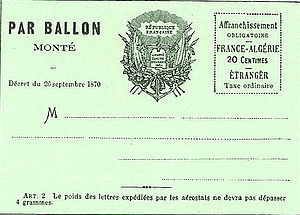Balloon mail

Balloon mail is the transport of mail (usually for weight reasons in the form of a postcard) carrying the name of the sender by means of an unguided hydrogen or helium filled balloon. Since the balloon is not controllable, the delivery of a balloon mail is left to good fortune; often the balloon and postcard are lost. A found balloon should be returned to the sender (by conventional post) with an indication of the discovery site, so the sender can determine how far their balloon flew. Balloon mail is often sent as part of a balloon competition.

In 1877, a 5-cent stamp for balloon postage was privately printed in Nashville, Tennessee, to carry mail on a June 18 flight of the "Buffalo Balloon" from that city to Gallatin, Tennessee. Of the 300 stamps produced, only 23 were used.[2]
Balloon mail was sent from Przemyśl, Poland (near the Ukrainian border), during World War I.[3]
Balloon mail has been used for spreading information and
References
- ^ Loving, Matthew. (2011) Bullets and Balloons: French airmail during the Siege of Paris. Franconian Press (Kindle edition).
- ^ The William Fekete Collection, Sale 1082, Siegel Auction Galleries, October 21–22, 2015, "New York, New York" p. 115.
- ^ Bennett, Russell and Watson, James; Philatelic Terms Illustrated, Stanley Gibbons Publications, London (1978).
- ^ Hearst Magazines (February 1956). "Balloon Wheel Dumps Leaflets". Popular Mechanics. Hearst Magazines. p. 151.
- ^ Sudworth, John (10 November 2008). "Storm looms over N Korea balloons". BBC News. Retrieved 11 November 2008.

